How to make plumbing in a private house: the system design,
If you are interested in how to properly make plumbing in a private house, then this review reveals everything that is important to know before starting such a case.
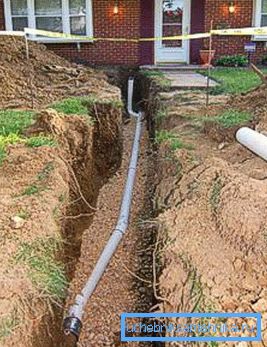
If specifically, in the article we will talk about such things:
- On what materials for mounting designs are on the market and which of this range is better to choose.
- How to make plumbing in the house without a central water supply.
- About how the elements can be connected.
And, of course, consider a lot of other points that will be useful in practice. Let's touch, including the installation scheme. Let's start with the main point.
How does the standard system work?
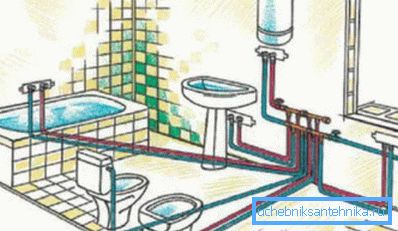
All "components" are published in the table below.
| Item Name: | Features: |
| Consumers. | This refers to devices that consume water in varying degrees. This may be, for example, a mixer or boiler. The bottom line is that it is precisely consumers who need to be guided in the period when the water supply system is being drawn up in the house. After all, the concept of planning will depend on what characteristics the devices will have, on the places and frequency of their location. |
| Pipeline. | These are, in fact, simply pipes through which water is supplied from the point of supply to consumers. |
| Source of water supply. | This can be either a tap from a central water supply system, or a well or a well. In the case of private houses, the last two options are quite common, so in such situations another element is automatically added - the water supply pump. |
In principle, such details as fittings - taps, corners and various adapters can be added to this list.

Let's talk in detail about the main elements of the system.
Selection of materials and equipment
The most important thing to understand is the difference between the construction market and the specialty store. On the market you can buy pipes, small parts, various fittings, as well as consumables. But the equipment is safer to purchase in specialized stores - in them the risk of running into a fake is much lower.
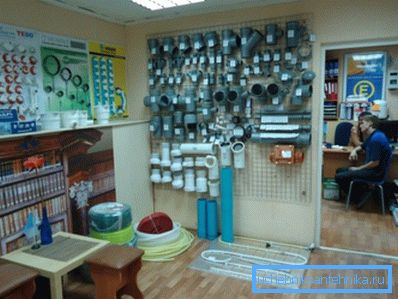
Advice: if there is such an opportunity in your city, then try to acquire equipment not only in stores, but from authorized dealers of this or that brand. Despite the fact that with such an approach, the cost of running a water supply system to a private house will increase slightly - but you will get a really high-quality system (provided that the installation was done correctly, of course).
Let's return to the rules for choosing materials and mixers.
Pipe selection
Now the installation of water supply in a private house can be made of such pipes:
- Of steel. The option is not bad in principle due to the fact that the strength of steel is very high - cracks or chips are almost impossible to form on the metal, except that in the case of a mechanical shock, dents may appear. However, there are more than enough deficiencies in the solution.
- Firstly, the metal is subject to corrosion, and this automatically spoils the quality of water and reduces the life of the system.
- Secondly, the connection will have to be done with the help of welding, and in a situation where the finishing of the house is finished, this can be a problem.
- Yes, and besides - work with welding is difficult for installation by hand, as the equipment is expensive, and there are no skills here.
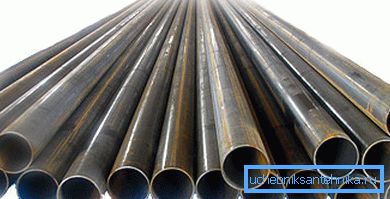
- From metal-plastic. This is a modern material, which consists of two layers of plastic, between which is a layer of aluminum. Advantages of the solution are ease of installation (all connections are, in fact, ordinary nuts), low material cost, and no risk of rust. The disadvantages are not very high pipe strength - they will not withstand strong mechanical stress.

- From polypropylene. The material is a solid piece of plastic, which is interconnected with a special soldering iron. This is a very convenient solution that can be quietly embedded in the walls, since the joints are truly monolithic - that is, there is simply no risk of leakage.
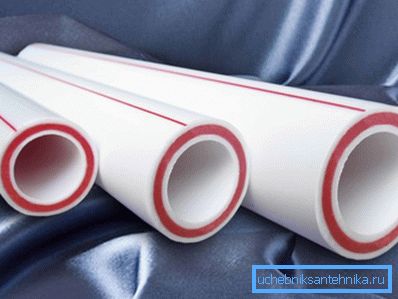
Note! Metal pipes have a fairly good level of heat transfer - that is, if hot water flows along it, the surface of the line will also be heated. But on the contrary polypropylene - poorly conducts temperature.
In principle, it turns out that the installation of plumbing in a private house is now most often made of polypropylene. We will consider it as a good example when we get to the installation scheme.
For now we will deal with one more moment.
Mixer selection
One of the key elements that contains any scheme of plumbing in a private house, are mixers.
These products are divided into the following categories:
- On the valve. In fact, these are devices in which water is supplied, regulated and blocked by means of valve taps. The advantage of the solution is the relatively low price and high maintainability, and the disadvantages are the “morally” outdated appearance, the design and the fact that the cranes have to change the gaskets quite often.
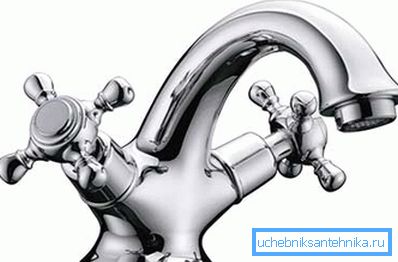
- On single lever. The devices consist of a spout, a control lever and a special cartridge through which water flows and mixes. The main advantages of products are the ease of operation, modern appearance, and the disadvantages include a higher cost than in the previous case. In addition, the disadvantage is that the mechanism of the cartridge is very sensitive to water quality and if it is very hard or with debris, then the cartridge will often fail. Therefore, the installation of water supply in a private house must contain coarse filters in front of the mixers.

Note! If there are small children in the house who use the sink, the sink, then it may be difficult to immediately learn how to adjust the optimum temperature with the help of a lever. Therefore, in such a situation, make sure that they are not scalded with hot water.
- On thermostatic. These models are equipped with a mechanism that does not allow to exceed the pre-set temperature. Inclusion in most cases occurs with the help of the built-in photocell - during the presentation of hands to the spout. This option is very good in terms of operating comfort, however there are two significant drawbacks - the high cost of the product and the not very long service life in the case of intensive use of devices.

Such are the mixers on the market.
It turns out that we have dealt with pipes and taps, now we can consider how the water supply to the private house itself is carried out.
Independent installation
It is worth noting that there are two ways of liner:
- From the central water supply.
- From the well or well.
In principle, the assembly scheme itself is identical in both cases, the difference is only in the point of connection to the supplier. In the situation with the central water supply, most likely, it will be necessary to dig trenches for the limits of the site for the transport line.
And in the case of an autonomous well, the number of pipes needed is reduced by several times, since drilling is usually carried out a few meters from the house. But it requires an electric pump to supply water to the top.
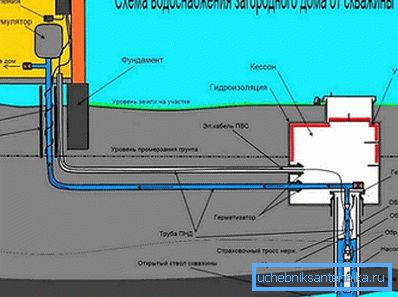
The very same connection with the “supplier” highway can be done in any way - at least by soldering, even with the help of nuts. With the connection, it turns out, everything is quite simple, but the instruction for laying the main line is more complicated.
Everything is done like this:
- A trench is being dug into the plot into which the trunk line will be laid. The trench depth must be greater than the freezing point of the ground. Also, to make sure that the water inside the pipes does not freeze, you can additionally warm the pipeline with mineral wool and film.
- At the bottom fit pre-welded sections of plastic pipes. Or, if steel is used as a highway, then the connections are usually welded on the surface right near the trench line, and then they are placed in the channel.

- A hole is made under the foundation of the house or directly in it. In concrete, it is organized using a perforator and a long drill.
Tip: do not try to drill the concrete with a large drill bit. The process will be easier if you first “pierce” the hole with a narrow nozzle, and then with a wider one.
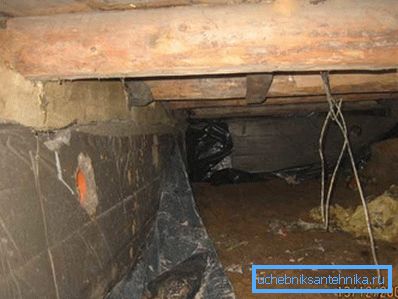
- Inside the house, through a previously made hole, a pipe is started and “released” upward so that its end is above the floor level.
- The water supply valve is turned on, and the installed section of the water supply is checked for leakage. If everything is in order, the trench is filled with soil and the work proceeds to the next stage.
It turns out that the water supply to the private house itself is completed, and the next stage is internal work.
They are performed mainly from plastic pipes, and everything happens in a fairly standard manner.
- In the plane of the walls are made grooves for laying the channel.
- Welded pipes are inserted into the space of strobe and grasped to the surface with the help of alabaster or any clamps.
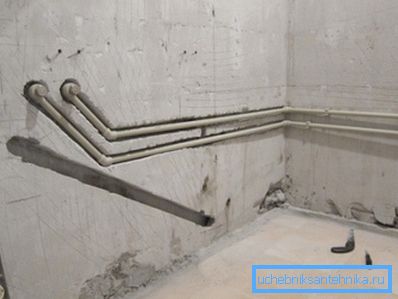
Tip: Try to fix the pipes as tightly as possible so that they do not twitch or vibrate during pressure drops. In principle, this is not particularly scary, since the connections made by the soldering iron are in some sense monolithic, but in any case, the extra vibration is not needed anyway.
- At the right points, the “tees” fittings are connected to the line, from which sections of pipes go to consumers (that is, to mixers, various drives, etc.).
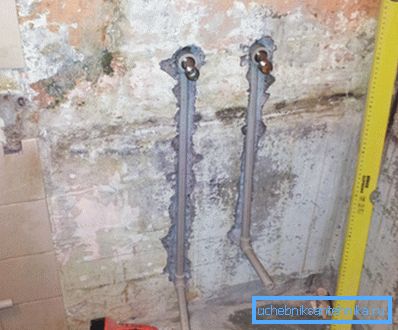
Well, then the system is checked to see if there are any leaks anywhere, then the pipes are sealed, and the consumers are connected to the taps.
On this, in general, everything, the article is finished, and we can summarize. We have discussed in some detail how to bring water into the house from a central type of water supply system, as well as from a well. In addition, we figured out what materials for assembling a structure exist on the market and what features they have.
We hope that this information will be useful to you in practice, and you will be able to organize the highest quality and comfortable plumbing system in your home. We recommend as additional information to view more and video in this article.